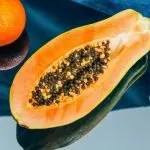
January 14, 2022 — 1:08 AM
It’s no secret seeds are healthy—like, really, really healthy. We use them as salad toppers for extra crunch, blend them into smoothies for more protein, and sprinkle them atop yogurt parfaits for bonus healthy fats. While virtually every seed packs some serious nutritional punch, they’re not all created equally. Take flax seeds and chia seeds, for example. These two powerhouse seeds are often considered interchangeable, however they do possess unique qualities that are worth highlighting. If you’ve ever wondered how flax seeds and chia seeds differ, experts are here to offer some insight.
Kim Rose, RDN, certified diabetes care and education specialist, describes flax seeds as a tiny, brown, tear-dropped seed with a slew of benefits including vitamin E, omega 3 fatty acids, and fiber. “For starters, vitamin E is a fat-soluble vitamin important for eye health, immune support, and may even play a role in preventing heart disease.” She also adds that flax seed contains alpha-linoleic acid (ALA), which is a form of omega-3 fatty acids that may improve memory, retention, and learning. Its fiber content helps us stay fuller for longer while keeping our bowels regular.
Katie Cavuto, R.D., adds that consuming ground flax has been linked to a reduction of LDL cholesterol levels (the bad kind) and improvement in HDL levels (the good kind). Flax is also rich in the polyphenol lignans, which may protect heart health and likelihood of some cancers.
Here are the nutrition facts for one ounce (2 Tbsp) of flax seeds:
- Fat: 10g
- Saturated fat: 1g
- Carbohydrates: 7g
- Fiber: 7g
- Sugar: 0g
- Protein: 4g
- Sodium: 5mg
Chia seeds, on the other hand, are versatile, grayish-brown seeds from the Salvia hispanica plant used in many recipes thanks to their diversity of health-touting benefits, according to Rose. “Chia seeds are packed with protein, [which] is important because it supplies the body with both strength and vigor,” she says. It also contains soluble fiber, which she describes as a type of fiber that expands in our digestive tract and increases satiety.
Plus, chia seeds may also help manage inflammation and reduce the risk of heart disease thanks to their omega-3 fatty acid content, says Cavuto.
Here are the nutrition facts for one ounce (2 Tbsp) of chia seeds:
- Fat: 9g
- Saturated fat: 1g
- Carbohydrates: 12g
- Fiber: 10g
- Sugar: 0g
- Protein: 5g
- Sodium: 5mg
How do flax and chia compare?
Functional Nutrition Training
A cutting-edge nutrition deep dive taught by the world’s foremost health & wellness experts.

Cavuto describes flax seeds as having a stronger, nuttier flavor than the mild chia seed. Flax generally needs to be ground to reap the benefit—as this makes it easier for the body to absorb its nutrients. Ground flaxseed is also called flaxseed meal and is easy to add to oatmeal or smoothies or sprinkled on salads.
Fun fact: Cavuto says the same one ounce serving of chia contains 179 milligrams of calcium, which rivals the 300 milligrams of calcium found in one cup of milk. However, calcium isn’t the be-all-end-all, especially if your diet is already filled with calcium-rich foods. While chia is a better source of calcium, flax provides several additional minerals including zinc and magnesium, she says.
Which is better: flax or chia?
Which is better for digestion?
While flax’s fiber content is slightly lower than chia, at about 8 grams versus 10, Cavuto says flax contains more insoluble fiber, which is more beneficial for those experiencing constipation. Plus, the lower overall fiber content coupled with the ratio of soluble to insoluble fiber makes flax a touch easier to tolerate than chia for those with a more sensitive digestive system, she says.
Cavuto warns that while the high fiber content in chia seed may sound super appealing if you’re feeling backed up, it’s easy to overdo it in chia pudding and smoothies. “I usually encourage my clients, especially those with sensitive digestive systems, to start small and tread lightly. The fiber in these tiny seeds can absorb over 10 times their weight in water…hello, chia pudding.” While chia seed’s fiber content will indeed leave you feeling fuller for longer, you might have to cope with some uncomfortable bloating.
Which is a better source of omega-3s?
Flax and chia seeds both contain ALA, a form of omega-3 found in nuts and seeds, says Rose, however, flax seed has a slightly higher amount of ALA compared to chia seed. In addition to offering healthy fats, flaxseed oil can also help drive vitamin D absorption when the two are taken together. Cavuto says it’s important to note that despite their substantial ALA content, this form is not as bioavailable to the body as the DHA and EPA found in fish and fish oil.
Which is better for protein?
When comparing plant-based protein, Rose says chia seeds have a slight edge over flax seeds, with an ounce of chia seeds containing almost 5 grams of plant-protein and an ounce of flax seed containing less than 4 grams of protein.
Chia seeds can be consumed whole or ground, says Rose. When whole, they provide a welcoming crunch to boost satiety and work well in parfaits, crackers, or jam since they tend to adapt the flavor of any dish. For ground chia, she recommends trying them in a pudding, mousse, or oatmeal. “Ground chia seeds are hydrophilic, or water-loving, so you may need to add a little more water to prevent your dish from drying out,” says Cavuto.
On the bright side, their next-level absorbency makes them work great as a vegan egg, according to Cavuto. Simply mix a tablespoon of the super-absorbent pellets with 2.5 tablespoons of water as an egg replacer. In general, she says even a small amount of chia makes an impact in the nutrition and taste departments. “Sprinkle them on your salad, add some to a smoothie or smoothie bowl and blend them into your favorite breakfast porridge,” she says.
Rose recommends grounding and sprinkling flax seed onto virtually any dish from salads to breakfast cereals and soups. “The mild, nutty flavor of flaxseeds provides a pleasantly clean flavor,” she says.
Cavuto recommends getting creative with ground flax in smoothies, yogurt, oats, and baked goods. “You can even whisk it into a salad dressing or pair it with peanut butter or avocado as a toast topper,” she says.
You’re likely not going to be using cups of flax at once, so you’ll need a proper storage solution in place. “The oils in flax, especially when bought ground, can go rancid fairly quickly so I usually recommend storing them in the fridge or freezer to prolong their shelf life,” says Cavuto.
Can you use them interchangeably in recipes?
Rose says that when both flax and chia are submerged for extended periods in water, they yield a gelatinous mixture similar to raw egg whites. You can use this vegan egg mixture or binding agent in cake mixes, burgers, and stuffing.
Recipes with flax or chia seeds
Because of their higher mineral and omega-3 content, we’re declaring flax the winner in this face-off. Although, it’s worth noting, these mighty seeds do offer very similar benefits.
“We have to remember nutrition isn’t one size fits all,” says Cavuto. “Everybody is different and depending on your body and your system, both or neither might be a good fit. I often remind clients to start small with new foods and to be mindful of the way a new food makes your body feel.”
Ultimately, both can be part of an overall healthy diet—just be mindful of your body’s unique needs.
https://www.mindbodygreen.com/articles/flax-seeds-vs-chia-seeds







